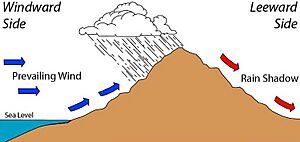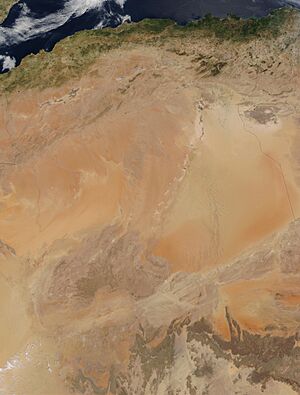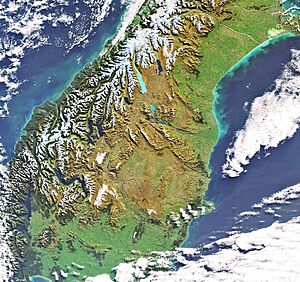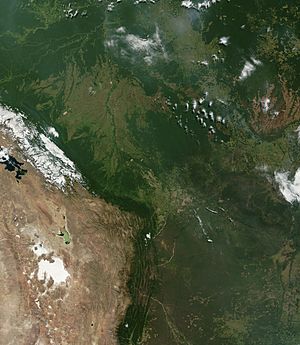Rain shadow facts for kids
A rain shadow is a dry area on one side of a mountain range. This side faces away from the direction the wind usually blows. It's called the "leeward" side. The other side, which faces the wind, is called the "windward" side.
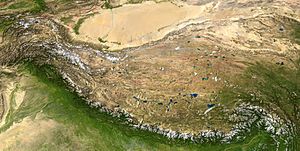
Imagine moist air from the ocean moving towards land. When this air hits tall mountains, it's forced to rise. As it goes higher, the air cools down. This cooling makes the moisture turn into clouds and then fall as precipitation (rain or snow) on the windward side of the mountain.
By the time the air reaches the top of the mountains, most of its moisture is gone. As this now-dry air moves down the other side (the leeward side), it gets warmer and can absorb more moisture. This creates a "shadow" of dry climate behind the mountains. This dry area often turns into shrub–steppe, dry shrublands, or even deserts.
Contents
Where Do Rain Shadows Happen?
Rain shadows are found all over the world, especially near large mountain ranges. They are created by the way global winds blow. For example, trade winds blow near the equator, and westerlies blow in the middle parts of the Earth.
Africa's Dry Zones
Northern Africa's Deserts
The huge Sahara Desert is made drier by two big mountain ranges. To the northwest are the Atlas Mountains in Morocco, Algeria, and Tunisia. To the southeast are the Ethiopian Highlands. Winds from the Atlantic Ocean carry moisture to the Atlas Mountains. The air rises, cools, and drops its rain on the ocean-facing side. The air that crosses the mountains is dry and warm, creating desert conditions in the Sahara.
The Ethiopian Highlands have an even stronger rain shadow effect. Tropical winds from the Indian Ocean and Arabian Sea bring rain to one side. But the other side stays extremely dry, making the eastern Sahara one of the driest places on Earth. Other dry areas in the Horn of Africa, like the Danakil Desert, are also affected by the Ethiopian Highlands.
Southern Africa's Dry Areas
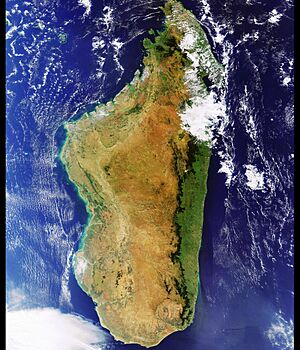
The island of Madagascar has wet, tropical forests on its eastern side, which faces the wind. But the western and southern parts are in the rain shadow of the central mountains. These areas have dry thorn forests and deserts. The same happens on the island of Réunion.
In Western Cape Province, South Africa, the Breede River Valley and the Karoo region are dry because they are in the rain shadow of the Cape Fold Mountains. While the mountains get a lot of rain, nearby Worcester gets very little.
Asia's Arid Lands
Central and Northern Asia's Deserts
The Himalaya mountains and other ranges help create dry conditions in Central Asia. This includes the Gobi Desert in Mongolia and the dry grasslands of Mongolia and northern China.
The Verkhoyansk Range in eastern Siberia is very cold. Moist winds from the Pacific Ocean lose their moisture over coastal mountains before reaching the Lena River valley. This makes places like Yakutsk extremely cold and dry in winter.
Eastern Asia's Rain Shadows
The Ordos Desert in China is dry because mountains like the Kara-naryn-ula and Yin Mountains block rainfall.
In Myanmar, the central region is dry because it's in the rain shadow of the Arakan Mountains. It gets much less rain than the coast.
The plains around Tokyo, Japan (the Kantō Plain), get less rain in winter. This is because surrounding mountains, like the Japanese Alps, block the cold, moist winds from Siberia.
Southern Asia's Dry Regions
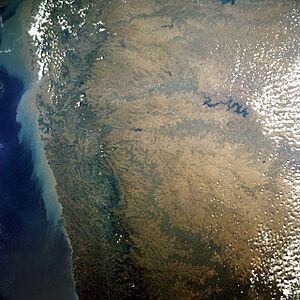
The eastern side of the Western Ghats in India, including areas like Vidarbha and Tamil Nadu, are in a rain shadow.
Gilgit and Chitral in Pakistan are also dry rain shadow areas.
The Thar Desert in India is surrounded by mountain ranges like the Aravalli Range and the Himalaya, which block rain.
The Central Highlands of Sri Lanka create a rain shadow for the northeastern parts of the island. These areas get less rain during the summer monsoon.
Western Asia's Dry Climates
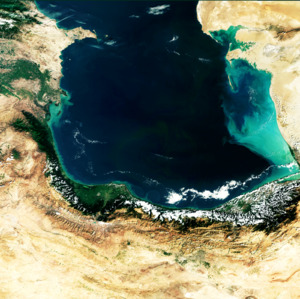
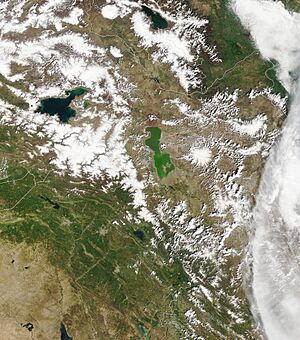
The Caucasus Mountains and Hindu Kush mountains create rain shadows for the Karakum Desert and Kyzyl Kum deserts east of the Caspian Sea. This also causes big differences in rainfall between wet coastal areas on the Black Sea and dry lowlands in Azerbaijan.
The dry Anatolian Plateau in Turkey is in the rain shadow of the Pontic Mountains to the north and the Taurus Mountains to the south.
The Judaean Desert and the Dead Sea area are dry because the Judaean Mountains block rain.
The Dasht-i-Lut desert in Iran is one of the driest places on Earth. It's in the rain shadow of the Elburz and Zagros Mountains.
The Mesaoria Plain in Cyprus is mostly dry due to the rain shadow of the Troodos Mountains.
Europe's Varied Climates
Central Europe's Dry Pockets
The plains of Limagne and Forez in central France are relatively dry. The Chaîne des Puys mountains block rain, so Clermont-Ferrand is one of the driest places in France.
Some valleys in the Alps are also very dry due to rain shadow. Examples include areas around Gap in France and Zernez in Switzerland.
Parts of Poland, like Kuyavia, get little rain (around 450 mm) because of the rain shadow from the Kashubian Switzerland hills.
Northern Europe's Contrasts
The Pennines in Northern England, the mountains of Wales, and the Scottish Highlands create a rain shadow for much of eastern United Kingdom. For example, Manchester gets about twice as much rain as Leeds.
Iceland has many small climate zones. Akureyri in the north gets about one-third of the rain that the island of Vestmannaeyjar gets off the south coast.
The Scandinavian Mountains create a rain shadow for areas east of the mountains. Bergen on the west coast gets a lot of rain (2250 mm), while Oslo in the east gets much less (760 mm). A deep valley called Skjåk gets only 280 mm of rain.
Southern Europe's Dry Areas
The Cantabrian Mountains in Spain divide the wet "Green Spain" in the north from the dry central plateau. The southern slopes are in a rain shadow. The areas of Almería, Murcia, and Alicante are the driest in Europe, getting only about 300 mm of rain. This is mainly because mountains to their west block the winds.
In Portugal, the Norte Region has huge differences in rainfall. Some areas get over 3000 mm, while the Douro Valley gets only about 500 mm.
The eastern Pyrenees mountains in southern France also create a rain shadow.
In Italy, the city of La Spezia on the Mediterranean coast gets twice as much rain as Rimini on the Adriatic side, due to the Apennines mountains.
The Vardar River valley in North Macedonia and areas south to Athens are in the rain shadow of the Accursed Mountains and Pindus Mountains. The windward side of the Accursed Mountains gets a lot of rain (around 5000 mm), but the leeward side gets as little as 400 mm.
Caribbean's Dry Sides
On the larger Caribbean islands, like Cuba and Hispaniola, the southwestern sides are in the rain shadow of the trade winds. These areas can get as little as 400 mm of rain per year, while the northeastern, windward sides get over 2000 mm. This leads to dry shrublands and deserts in parts of the Dominican Republic and Haiti.
North American Mainland's Deserts
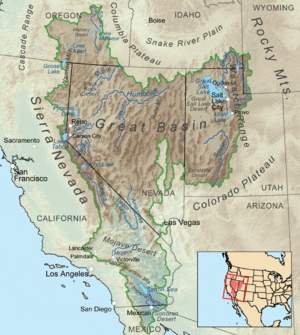
Most of the Interior Plains of North America are protected from moist Pacific weather by the North American Cordillera mountain range. Even stronger rain shadows are found in specific valleys within these mountains, especially in the Basin and Range Province.
The Pacific Coast Ranges create rain shadows near the West Coast:
- The Dungeness Valley in Washington is in the rain shadow of the Olympic Mountains. It gets only 10–15 inches of rain per year. Seattle is also slightly affected. In contrast, Aberdeen, southwest of the Olympics, gets almost 85 inches of rain.
- The eastern slopes of the Coast Ranges in California block enough rain to create desert-like conditions around Bakersfield.
- San Jose is drier than other parts of the San Francisco Bay Area because of the rain shadow from the Santa Cruz Mountains.
- The Sonoran Desert is dry because of the Peninsular Ranges to its west.
- The Sierra Madre Occidental mountains in Mexico are west of the Chihuahuan Desert.
Many rain shadows in the western United States are caused by the Sierra Nevada mountains in California and the Cascade Range in Oregon and Washington.
- The Cascades create a dry Columbia Basin in Eastern Washington and valleys in British Columbia, Canada.
- The dry Great Basin of Utah and Nevada is in the rain shadows of the Cascades and Sierra Nevada.
- The Mojave Desert is dry due to the Sierra Nevada and Transverse Ranges.
- Death Valley in the United States, behind both the Pacific Coast Ranges and the Sierra Nevada, is the driest place in North America.
The Colorado Front Range blocks rain from crossing the Continental Divide of the Americas. While areas west of the Divide get a lot of rain, cities like Denver and Pueblo, Colorado on the eastern side get much less.
Further east:
- The Shenandoah Valley in Virginia is much drier than the rest of the state. It's protected from moisture by the Ridge-and-Valley Appalachians and the Blue Ridge Mountains.
- Asheville, North Carolina, is in the rain shadow of the Great Balsam Mountains and Great Smoky Mountains. The surrounding mountains get over 100 inches of rain, but Asheville itself is the driest place in North Carolina, with only about 37 inches annually.
- Ashcroft, Canada, has the only true desert in Canada. It's in the rain shadow of the Coast Mountains.
- Yellowknife, Canada, is in the rain shadow of mountains to its west.
Oceania's Dry Regions
Australia's Rain Shadows
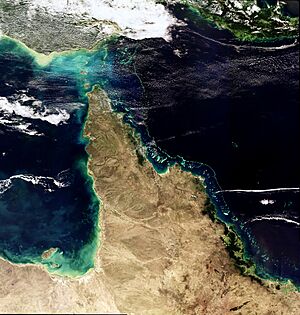
In New South Wales, the Monaro region is dry because it's shielded by the Snowy Mountains and coastal ranges. Cooma gets 535 mm of rain, while Batlow on the western side gets 1,220 mm. Australia's capital, Canberra, also has a strong rain shadow from the Brindabellas, getting 580 mm of rain annually.
In Queensland, the land west of the Atherton Tableland is in a rain shadow. Tully on the eastern side gets over 4000 mm of rain, but Mareeba in the rain shadow gets only 870 mm.
In Tasmania, the central Midlands region is very dry, getting only about one-fifth as much rain as the western highlands.
In Victoria, the western side of Port Phillip Bay is in the rain shadow of the Otway Ranges. The area between Geelong and Werribee is the driest part of southern Victoria, supporting only grasslands.
In Western Australia, the Wheatbelt and Great Southern regions are shielded by the Darling Range. Mandurah near the coast gets 700 mm, while Narrogin, further east in the rain shadow, gets less than 500 mm.
Pacific Islands' Dry Sides
Hawaii also has rain shadows, with some areas being deserts. The island of Kauai gets a lot of rain on its windward side, but the leeward side is very dry. The entire island of Kahoolawe is in the rain shadow of Maui's East Maui Volcano.
New Caledonia is a tropical island, but its western side is in the rain shadow of the central mountains, so it gets much less rainfall.
In the South Island of New Zealand, the Southern Alps create one of the most amazing rain shadows. The western side gets huge amounts of rain (6,300 to 8,900 mm), creating large glaciers. But just 50 km (30 mi) to the east, the yearly rainfall drops to less than 760 mm, and some areas get less than 380 mm.
South America's Arid Regions
The Atacama Desert in Chile is the driest non-polar desert on Earth. It's blocked from moisture by the Andes Mountains to the east.
Cuyo and Eastern Patagonia in Argentina are dry because the Andes mountains block the westerly winds. The Argentinian wine region of Cuyo depends almost completely on irrigation, using water from rivers fed by melting ice from the Andes.
The Guajira Peninsula in northern Colombia is in the rain shadow of the Sierra Nevada de Santa Marta. Despite being in the tropics, it's almost a desert, getting almost no rain for seven to eight months of the year.
See also
 In Spanish: Sombra orográfica para niños
In Spanish: Sombra orográfica para niños
- Lake-effect snow
- Orographic precipitation
- Wind shadow


